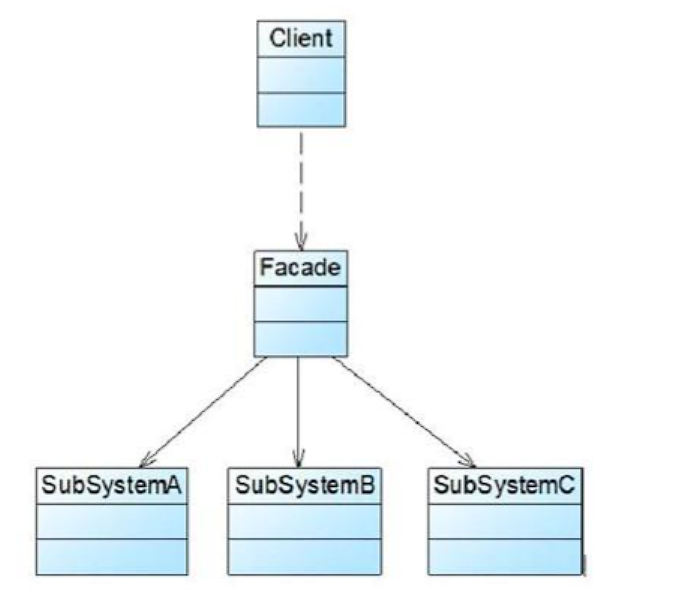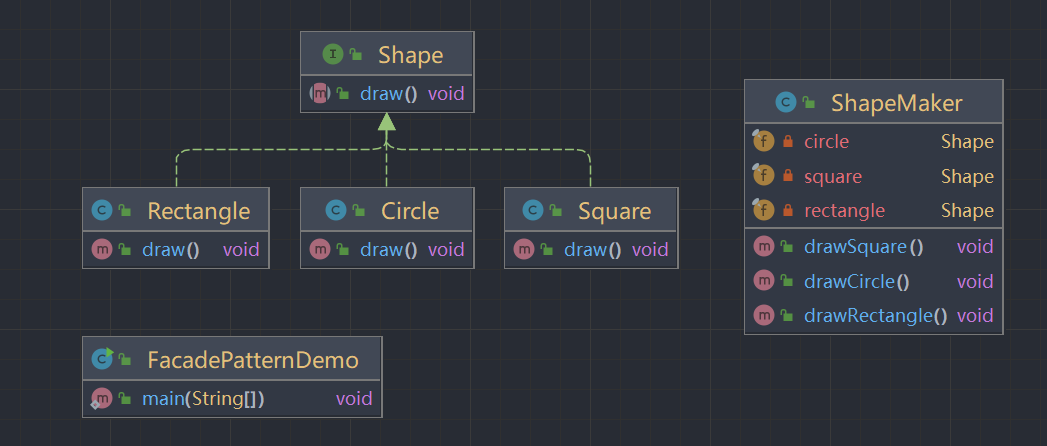 设计模式-外观模式
设计模式-外观模式
# 设计模式-外观模式
# 概述
当我们想要吃一个汉堡的时候,我们有两种方式,一是自己做,二是去店里买。
如果我们自己做,我们就需要去和食材这一列复杂的东西交互。而去店里买,我们只需要和服务员进行交互。
在软件开发中有时候为了完成一项较为复杂的功能,一个客户类需要和多个业务类交互,由于涉及的类比较多,导致使用代码较为复杂,此时特别需要一个类似服务员的角色,有它来负责和多个业务类进行交互,而客户类只需要与该类交互。
# 定义
为子系统中的一组接口提供一个统一的入口。外观模式定义了一个高层接口,这个接口使得子系统更加容易使用。
# 外观模式结构
外观模式包含以下两个角色:
外观角色(Facade) :在客户端可以调用它的方法,在外观角色中可以知道相关的子系统的功能和责任。
子系统角色(SubSystem):在软件系统中可以有一个或者多个子系统角色,每一个子系统可以不是一个单独的类,而是一个类的集合,实现子系统的功能。

# 外观模式应用案例

1、创建一个图形接口
public interface Shape {
void draw();
}
2、创建三个基本图形
public class Circle implements Shape {
@Override
public void draw() {
System.out.println("Shape: Circle");
}
}
public class Rectangle implements Shape {
@Override
public void draw() {
System.out.println("Shape: Rectangle");
}
}
public class Square implements Shape{
@Override
public void draw() {
System.out.println("Square::draw()");
}
}
3、创建这些图形的外观类
public class ShapeMaker {
private final Shape circle;
private final Shape rectangle;
private final Shape square;
public ShapeMaker() {
circle = new Circle();
rectangle = new Rectangle();
square = new Square();
}
public void drawCircle() {
circle.draw();
}
public void drawRectangle() {
rectangle.draw();
}
public void drawSquare() {
square.draw();
}
}
4、案例实现
public class FacadePatternDemo {
public static void main(String[] args) {
ShapeMaker shapeMaker = new ShapeMaker();
shapeMaker.drawCircle();
shapeMaker.drawRectangle();
shapeMaker.drawSquare();
}
}
// 输出
Shape: Circle
Shape: Rectangle
Square::draw()
# 外观模式优缺点
优点:
- 它对客户端屏蔽了子系统组件,减少了客户端所需处理的对象数目,并使子系统使用更加容易。
- 实现了子系统与客户端之间的松耦合关系,使得子系统的变化不会影响到调用它的客户端。
- 一个子系统的修改对其他子系统没有任何影响,而且子系统内部变化也不会影响到外观对象。
缺点:
- 不能很好地限制客户端直接调用子系统类,如果对客户端访问子系统类做太多的限制减少了可变性和灵活性。
- 如果设计不当,增加新的子系统可能需要额外修改外观类的源代码。
# 外观模式使用环境
为复杂的模块或子系统提供外界访问的模块。
子系统相对独立。
预防低水平人员带来的风险。
# 参考
Java设计模式
上次更新: 2024/06/29, 15:13:44
